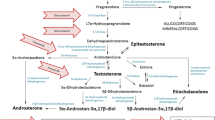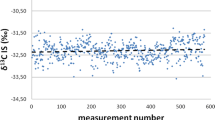Abstract
The hydrogen isotope ratio (HIR) of body water and, therefore, of all endogenously synthesized compounds in humans, is mainly affected by the HIR of ingested drinking water. As a consequence, the entire organism and all of its synthesized substrates will reflect alterations in the isotope ratio of drinking water, which depends on the duration of exposure. To investigate the effect of this change on endogenous urinary steroids relevant to doping-control analysis the hydrogen isotope composition of potable water was suddenly enriched from -50 to 200 ‰ and maintained at this level for two weeks for two individuals. The steroids under investigation were 5β-pregnane-3α,20α-diol, 5α-androst-16-en-3α-ol, 3α-hydroxy-5α-androstan-17-one (ANDRO), 3α-hydroxy-5β-androstan-17-one (ETIO), 5α-androstane-3α,17β-diol, and 5β-androstane-3α,17β-diol (excreted as glucuronides) and ETIO, ANDRO and 3β-hydroxyandrost-5-en-17-one (excreted as sulfates). The HIR of body water was estimated by determination of the HIR of total native urine, to trace the induced changes. The hydrogen in steroids is partly derived from the total amount of body water and cholesterol-enrichment could be calculated by use of these data. Although the sum of changes in the isotopic composition of body water was 150 ‰, shifts of approximately 30 ‰ were observed for urinary steroids. Parallel enrichment in their HIR was observed for most of the steroids, and none of the differences between the HIR of individual steroids was elevated beyond recently established thresholds. This finding is important to sports drug testing because it supports the intended use of this novel and complementary methodology even in cases where athletes have drunk water of different HIR, a plausible and, presumably, inevitable scenario while traveling.





Similar content being viewed by others
References
Piper T, Thomas A, Thevis M, Saugy M (2012) Drug Test Anal 4:717–727
Coplen TB (2011) Rapid Commun Mass Spectrom 25:2538–2560
Piper T, Baume N, Strahm E, Emery C, Saugy M (2012) Steroids 77:644–654
Solberg HE (1993) J Int Fed Clin Chem 5:162–165
Flenker U, Güntner U, Schänzer W (2008) Steroids 73:408–416
Piper T, Mareck U, Geyer H, Flenker U, Thevis M, Platen P, Schänzer W (2008) Rapid Commun Mass Spectrom 22:2161–2175
Piper T, Opfermann G, Thevis M, Schänzer W (2010) Rapid Commun Mass Spectrom 24:3171–3181
Friedman I (1953) Geochim Cosmochim Acta 4:89–103
Bowen GJ, Winter DA, Spero HJ, Zierenberg RA, Reeder MD, Cerling TE, Ehleringer JR (2005) Rapid Commun Mass Spectrom 19:3442–3450
Brencic M, Vreca P (2006) Rapid Commun Mass Spectrom 20:3205–3212
Bowen GJ, Ehleringer JR, Chesson LA, Stange E, Cerling TE (2007) Water Resour Res 43:W03419
Kim GE, Ryu JS, Shin WJ, Bong YS, Lee KS, Choi MS (2012) Rapid Commun Mass Spectrom 26:195–204
Data available at: http://wateriso.eas.purdue.edu/waterisotopes/index.html (accessed 27.07.2012)
Koehler K, Braun H, De Marees M, Fusch G, Fusch C, Mester J, Schänzer W (2010) J Sports Sci 13:1435–1449
Mareck U, Geyer H, Opfermann G, Thevis M, Schänzer W (2008) J Mass Spectrom 43:877–891
Piper T, Thevis M, Flenker U, Schänzer W (2009) Rapid Commun Mass Spectrom 23:1917–1926
Werner RA, Brand WA (2001) Rapid Commun Mass Spectrom 15:501–519
Docherty G, Jones V, Evershed P (2001) Rapid Commun Mass Spectrom 15:730–738
Morrison J, Brockwell T, Merren T, Fourel F, Phillips AM (2001) Anal Chem 73:3570–3575
Meier-Augenstein W (2010) In: Meier-Augenstein W (ed) Stable isotope forensics: an introduction to the forensic application of stable isotope analysis. Wiley, Oxford, pp 85–90
Schoeller DA, Colligan AS, Shriver T, Avak H, Bartok-Olson C (2000) J Mass Spectrom 35:1128–1132
London IM, Rittenberg D (1950) J Biol Chem 184:687–691
Goodman DS, Noble RP (1968) J Clin Invest 47:231–241
Goodman DWS, Smith FR, Seplowitz AH, Ramakrishnan R, Dell RB (1980) J Lipid Res 21:699–713
Neese RA, Faix D, Kletke C, Wu K, Wang AC, Shackleton CHL, Hellerstein MK (1993) Am J Physiol Endocrinol Metab 264:E136–E147
Zimmerman J (1986) Untersuchungen zum Nachweis von exogenen Gaben von Testosteron. Thesis, Deutsche Sporthochschule Köln, Cologne
Rauth S (1994) Referenzbereiche von urinären Steroidkonzentrationen und Steroidquotienten. Thesis, Deutsche Sporthochschule Köln, Cologne
Schoenheimer R, Rittenberg D (1937) J Biol Chem 121:235–253
Halford JO, Anderson LC, Bates JR (1934) J Am Chem Soc 56:491–492
Vestergaard P (1978) Acta Endocrinol Suppl 217:96–120
Acknowledgments
This project was partly funded by the Partnership for Clean Competition (PCC), the Federal Ministry of the Interior of the Federal Republic of Germany and the Manfred-Donike-Institute for Doping Analysis (MDI), Cologne. The authors would like to thank Dr Karsten Köhler for his assistance in interpreting the dietary records.
Author information
Authors and Affiliations
Corresponding author
Additional information
Published in the topical collection Isotope Ratio Measurements: New Developments and Applications with guest editors Klaus G. Heumann and Torsten C. Schmidt.
Rights and permissions
About this article
Cite this article
Piper, T., Degenhardt, K., Federherr, E. et al. Effect of changes in the deuterium content of drinking water on the hydrogen isotope ratio of urinary steroids in the context of sports drug testing. Anal Bioanal Chem 405, 2911–2921 (2013). https://doi.org/10.1007/s00216-012-6504-7
Received:
Revised:
Accepted:
Published:
Issue Date:
DOI: https://doi.org/10.1007/s00216-012-6504-7




